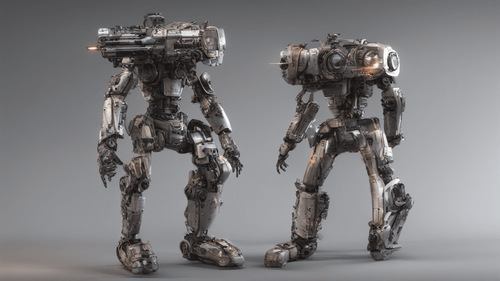
Introduction
In a realm where technology continuously evolves, the emergence of Hubot robots has sparked a new era of innovation. These remarkable machines, designed to mimic human interaction and perform tasks autonomously, are revolutionizing industries and daily life. In this comprehensive guide, we delve into the intricacies of Hubot robots, exploring their functionalities, applications, and the profound impact they have on modern technology.
Hubot Robot: A Paradigm Shift in Automation
Defining Hubot Robots: The Essence of Robotic Interaction
Hubot robots, short for "human-robot," epitomize the amalgamation of artificial intelligence and automation. They are intelligently crafted machines that simulate human interaction through natural language processing, allowing seamless communication and collaboration between humans and machines.
How Do Hubot Robots Work: Decoding the Mechanism
At the core of Hubot robots lies a complex web of algorithms, artificial intelligence, and sensor integration. These robots are equipped with advanced speech recognition and language generation capabilities, enabling them to understand and respond to human commands, questions, and prompts.
The Role of AI: Powering Hubot Robots
Artificial intelligence serves as the backbone of Hubot robots. Machine learning algorithms enable these robots to continuously improve their communication skills and adapt to various scenarios. As they interact with humans and gather data, they enhance their linguistic and problem-solving abilities.
Hubot Robot Applications: From Industry to Daily Life
Transforming Customer Service: Hubot Robots in E-Commerce
Hubot robots have reshaped the customer service landscape. E-commerce giants employ these robots to provide real-time assistance, answer queries, and guide customers through their online shopping experience. This translates to enhanced customer satisfaction and increased sales.
Healthcare Revolution: Hubot Robots in Medical Facilities
In the healthcare sector, Hubot robots are making profound strides. They assist medical professionals by delivering medications, monitoring patients' vital signs, and even conducting preliminary diagnoses. This not only streamlines processes but also ensures accurate and timely patient care.
Educational Companions: Hubot Robots in Learning Environments
Imagine having a robotic study companion! Hubot robots are increasingly being integrated into classrooms to aid educators and students alike. They provide personalized tutoring, answer questions, and create interactive learning experiences, catering to diverse learning styles.
Industrial Automation: Hubot Robots in Manufacturing
The manufacturing industry has embraced Hubot robots to optimize production processes. These robots are adept at performing repetitive and precision-oriented tasks, leading to higher efficiency, reduced errors, and cost savings for manufacturers.
Impact and Considerations: Ethical Aspects of Hubot Robots
Hubot Robots and Human Interaction: Navigating Ethical Boundaries
While Hubot robots offer undeniable benefits, ethical considerations arise when they mimic human emotions and behaviors too closely. Striking a balance between seamless interaction and ethical boundaries is imperative to avoid blurring the lines between humans and machines.
Data Privacy and Security: Safeguarding Sensitive Information
As Hubot robots engage in conversations and gather user data, ensuring data privacy becomes paramount. Developers must implement robust security measures to protect sensitive information and prevent breaches that could compromise user trust.
Frequently Asked Questions (FAQs)
How are Hubot robots different from traditional robots?
Hubot robots stand apart by their sophisticated natural language processing abilities, enabling them to engage in human-like conversations and interactions.
Can Hubot robots replace human jobs?
Hubot robots are designed to augment human capabilities, not replace them. They excel in tasks that require efficiency and precision, allowing humans to focus on complex decision-making and creative endeavors.
Are there limitations to Hubot robots' language understanding?
While Hubot robots have made significant strides in language comprehension, nuances, idioms, and context-specific meanings can still pose challenges for accurate interpretation.
What role does machine learning play in Hubot robots?
Machine learning empowers Hubot robots to continuously improve their communication skills. They learn from every interaction, adapting their responses to enhance user satisfaction.
Can Hubot robots be customized for specific tasks?
Absolutely. Hubot robots can be programmed and customized to perform a wide range of tasks, making them versatile tools for various industries.
What does the future hold for Hubot robots?
The future of Hubot robots is promising. With ongoing advancements in AI and robotics, we can anticipate even more sophisticated interactions and applications that will shape various sectors.
Conclusion
In the realm of technology, Hubot robots represent an awe-inspiring fusion of human-like interaction and advanced AI. These remarkable creations have ushered in a new era of possibilities, transforming industries such as customer service, healthcare, education, and manufacturing. While we embrace the benefits, ethical considerations and data privacy concerns remain pivotal for responsible integration. As Hubot robots continue to evolve, their journey intersects with ours, shaping the way we interact with machines and the world around us.
So there you have it – a comprehensive guide unraveling the world of Hubot robots, from their inception to their multifaceted applications. As we embark on this journey of technological innovation, the collaboration between humans and Hubot robots promises a future of endless potential.